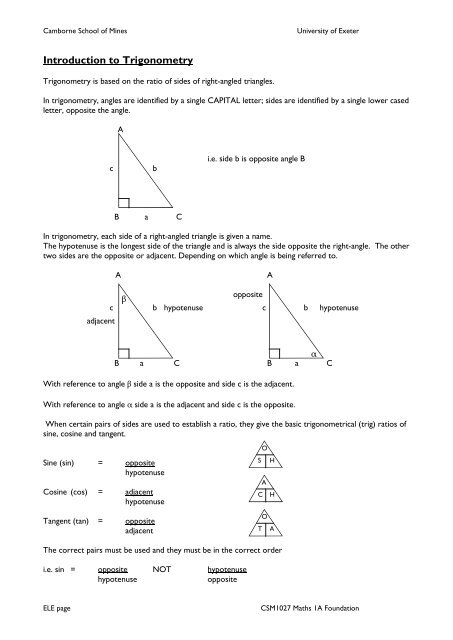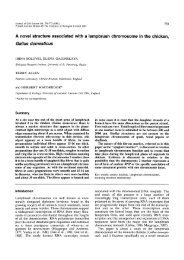Introduction to Trigonometry - University of Exeter
Introduction to Trigonometry - University of Exeter
Introduction to Trigonometry - University of Exeter
You also want an ePaper? Increase the reach of your titles
YUMPU automatically turns print PDFs into web optimized ePapers that Google loves.
Camborne School <strong>of</strong> Mines<strong>University</strong> <strong>of</strong> <strong>Exeter</strong>The numerical value <strong>of</strong> the trig ratios for any angle can be found using tables or a scientific calcula<strong>to</strong>r.Find the relevant trig function but<strong>to</strong>n on the calcula<strong>to</strong>r and type in the angle. The trig function value will bedisplayed. E.g. find the value <strong>of</strong> sin 45°If the trig function and it value are known, the corresponding angle can be found.E.g.if the sin <strong>of</strong> an unknown angle is 0.8660, what size is the angle?Find the inverse sin or sin -1 but<strong>to</strong>n on the calcula<strong>to</strong>r (Shift sin) and enter 0.8660 in<strong>to</strong> the calcula<strong>to</strong>r.The display will show 60. So, 0.8660 is the sin <strong>of</strong> 60°. This is usually written assin -1 0.8660 = 60°‘Solve’ the triangleFor any right-angled triangle, provided two pieces <strong>of</strong> information are known, (sides or angles) trig ratios canbe used <strong>to</strong> ‘solve’ the triangle.Solve means determine the size <strong>of</strong> all angles and the length <strong>of</strong> all sides.To calculate the length <strong>of</strong> a side, an angle and one side must already be known.To calculate the size <strong>of</strong> an angle, two sides must already be known.E.g. in the triangle ABC which is right-angled at B, side a = 8cm and angle C = 36°. Solve the triangleAc b always draw a diagram from the information givenB a = 8cm CInformation already known is one side and one angle – so a side must be calculated.To find side c (could have chosen b – it doesn’t matter which is found first)Angle C = 36°. Side already known relative <strong>to</strong> angle C is the adjacent. Side required (c) relative <strong>to</strong> angle Cis the opposite.Trig function that relates adjacent and opposite is tan∴ tan C = oppositeadjacent∴ tan 36° = c8∴ 0.7265 = c ∴ c = 0.7265 x 8 = 5.81cm8ELE pageCSM1027 Maths 1A Foundation
Camborne School <strong>of</strong> Mines<strong>University</strong> <strong>of</strong> <strong>Exeter</strong>To calculate side bThis time the side required is the hypotenuse, and the side already known is still the adjacent. The trigfunction that relates adjacent and hypotenuse is cos.∴ cos C = adjacenthypotenuse∴ cos 36° = 8hypotenuse∴ 0.8090 = 8 ∴ hyp = 8 = 9.89cmhyp 0.8090To calculate the size <strong>of</strong> angle AAll three sides are known, any two can be used <strong>to</strong> determine an angle.Relative <strong>to</strong> angle A, side a is the opposite and side b is the hypotenuse. The trig function that relatesopposite and hypotenuse is sin∴ sinA = oppositeHypotenuse∴ sin -1 0.8089 = 53.99°= 8 = 0.80899.89ELE pageCSM1027 Maths 1A Foundation
Camborne School <strong>of</strong> Mines<strong>University</strong> <strong>of</strong> <strong>Exeter</strong>Practical Problems Using <strong>Trigonometry</strong>Once basic trig functions can be used <strong>to</strong> ‘solve’ right angled triangles, they can be used <strong>to</strong> solvepractical problems provided right angled triangles can be constructed from the information given.In order <strong>to</strong> do this, the definition <strong>of</strong> particular angles must be known. The definitions are givenbelow:BearingsAll bearings are quoted from due north, clockwiseeg. A ship leaves port on a bearing <strong>of</strong> 32 0 Ndirection <strong>of</strong> shipbearing 32 0PortElevationAngles <strong>of</strong> elevation are measured from horizontal upwardseg. The angle <strong>of</strong> elevation <strong>of</strong> the <strong>to</strong>p <strong>of</strong> a mast is 40 0angle <strong>of</strong> elevationmast40 0horizontalDepressionAngles <strong>of</strong> depression are measured from horizontal downwardseg. The angle <strong>of</strong> depression <strong>of</strong> a buoy at sea from the <strong>to</strong>p <strong>of</strong> a cliff is 55 0horizontalcliff55 0 angle <strong>of</strong> depressionseabuoyELE pageCSM1027 Maths 1A Foundation
Camborne School <strong>of</strong> Mines<strong>University</strong> <strong>of</strong> <strong>Exeter</strong><strong>Introduction</strong> <strong>to</strong> <strong>Trigonometry</strong> Worksheet 1Using trig methods solve the following triangles (i.e. all angles and sides)9.61. 2. 3.12 12 1321.248°4. The angle <strong>of</strong> elevation <strong>of</strong> the <strong>to</strong>p <strong>of</strong> a <strong>to</strong>wer is 36 0 . If the <strong>to</strong>wer is 25m away from theobserver, calculate its height.5. A man 1.8m tall is standing 12m away from a tree. If the angle <strong>of</strong> elevation <strong>of</strong> the <strong>to</strong>p <strong>of</strong> thetree is 24 0 14’, calculate the height <strong>of</strong> the tree.6. A point K is 12km due west <strong>of</strong> a second point L and 25km due south <strong>of</strong> a third point M.Calculate the bearing <strong>of</strong> L from M.<strong>Introduction</strong> <strong>to</strong> <strong>Trigonometry</strong> Worksheet 2Using trig methods solve the following triangles (i.e. all angles and sides)1. 2. 3.11.2816°64°1928°4. Point Y is 1km due north <strong>of</strong> point X. The bearings <strong>of</strong> point Z from X and Y are 26°30’ and42°40’ respectively. Calculate the distance from point Y <strong>to</strong> point Z.5. A ship steams 4km due north <strong>of</strong> a point then 3km on a bearing <strong>of</strong> 040°. Calculate thedirect distance between the starting and finishing points.6. The angles <strong>of</strong> elevation <strong>of</strong> the <strong>to</strong>p <strong>of</strong> a <strong>to</strong>wer from A and B, two points in line with its footare 27° and 32° respectively. If the distance between A and B is 21m, calculate the heigh<strong>to</strong>f the <strong>to</strong>wer.ELE pageCSM1027 Maths 1A Foundation
















